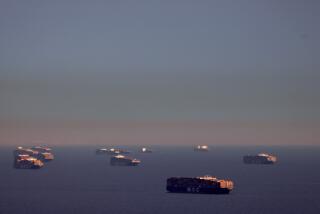Coast Guard Sets Dragnet--to Save Fish
- Share via
ABOARD THE STURGEON BAY — Fifteen miles off the coast of Maine, the Coast Guard cutter Sturgeon Bay spots its target.
Petty Officer Leonard Edwards and his team, armed with guns and wearing bulletproof vests, scramble into a small rubber boat. They race toward an aging fishing vessel, the Edna B., a wooden dragger out of West Point, Maine.
“If they’re in trouble, we’re here to help,” Edwards says. “If it’s illegal, they better watch out.”
Edwards and his uniformed team board the paint-chipped boat while the captain and crew of the “mother ship,” the 140-foot Sturgeon Bay, wait in the distance, watching through binoculars.
High drama on the high seas? Well, not really.
The Coast Guard boarding team is on a fish hunt.
Edwards is a “fish cop,” charged with enforcing strict new federal regulations designed to rebuild New England’s depleted stocks of ground fish--cod, haddock, halibut and yellowtail flounder that swim near the ocean floor.
The new federal ground-fishing rules, which went into effect July 1, are supposed to replenish the fish by giving them time to spawn and mature. Although they may help future fishermen, today’s fishermen say the regulations will put them out of business.
“The endangered species are becoming us,” said Bob Robertson, 59, of Boothbay, who owns a 39-foot boat.
The restrictions essentially expand on conservation methods established by the National Marine Fisheries Service in 1994.
The new laws, which cover all U.S. territorial waters from the Canadian border to New York, close some fishing grounds, limit the total ground-fish catch and make drastic cuts in the number of days boats can fish each year.
“I have a lot of respect for fishermen,” says Edwards, who boards about 15 boats every 24 hours. “I know they have a tough job. I just make sure they keep it safe and they follow what laws may apply to them. It’s their livelihood.”
A livelihood that is slowly dying, along with the fish caught in the huge nets dragged along the ocean floor.
Clint Richardson Jr. of Phippsburg, the owner of the Edna B., pulled in his nets, as required in Coast Guard boardings, and stared at the small dab fish, two monkfish and worthless lungfish and sea stars he pulled from the ocean bottom. “If I’d dumped something like this 10 years ago, I’d be upset,” Richardson said.
The catch is so small these days that Richardson mans his boat alone. “There just isn’t enough work to hire a guy,” he says.
During the hourlong boarding, Edwards measures the mesh size of Richardson’s nets to make sure it’s no smaller than 6 inches. The Coast Guard then tallies the types and amount of the fish on board to make sure Richardson isn’t taking more than he’s allowed.
Edwards also records what fish are discarded as waste. All that data is passed along to the National Marine Fisheries Service to help monitor the fishery.
So far this year, the Coast Guard has recorded two major violations against the owners of two ground-fishing vessels. The Coast Guard seized and sold more than 31,000 pounds of fish--worth $53,000--from a Portland, Maine, boat that allegedly exceeded the number of days fishermen can spend at sea.
In the second case, federal agents from the National Marine Fisheries Service seized about $9,000 worth of fish from a 64-foot dragger, whose owners allegedly broke the same days-at-sea rule.
More to Read
Sign up for The Wild
We’ll help you find the best places to hike, bike and run, as well as the perfect silent spots for meditation and yoga.
You may occasionally receive promotional content from the Los Angeles Times.






